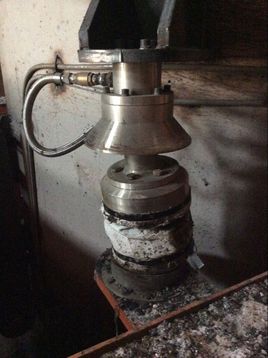- 10
- Oct
How to improve the efficiency of ladle argon blowing
How to improve the efficiency of ladle argon blowing
1. Improve the masonry craftsmanship. Before repairing the tank, check the ventilating brick. The working surface of the ventilating brick is not less than 30mm from the bottom of the tank to avoid cold steel; check whether the metal hose is burned out and whether the two screws are loose, and deal with it if necessary. In order to ensure the strength of argon blowing and reduce the penetration and blockage of molten steel, check the slit air passage of the breathable brick with a feeler gauge before masonry, and select the breathable brick with the appropriate width of the air passage under the working conditions; check whether the thread of the breathable brick tail pipe is damaged before masonry. Make sure that the tail pipe does not enter dust and debris during the process of laying the breathable bricks. After the ladle is repaired, the waste of the ventilating brick head should be cleaned up.
2. Use carefully. In the process of using ventilated bricks, the argon flow is strictly controlled in different treatment stages to avoid high-flow bottom blowing to accelerate the corrosion of bottom-blowing ventilating bricks. In the process of use, I often check the connection of the gas pipeline and find that the joint leaks are dealt with immediately to avoid gas leakage, which causes the pressure in the pipeline to drop and cause bottom blowing failure.
3. Strengthen the protection of breathable bricks. Due to the corrosion of bottom-blown venting bricks, the concave parts are likely to accumulate steel. After the steel is poured according to the rules, the air source (argon or compressed air) is immediately connected to the large ladle rotary table, and the air ducts without condensed steel and bottom-blown venting bricks are blown out. Steel accumulation in depressions. After turning the ladle and dumping the slag, hoist it to the hot repair area and put it down, and then connect the quick connector to test the flow rate of the breathable brick with compressed air or argon. If the flow rate requirement is reached, the quick connector can be pulled out without treatment or slim Treatment; if the flow rate cannot meet the requirements, the oxygen-burning back-blowing method is adopted. The specific method is: the venting brick is connected to the high-pressure air source, and at the same time, oxygen or coal oxygen lances are used on the front of the ladle to remove the cold steel and cold slag remaining on the working surface of the venting brick. Until the flow rate of the breathable brick reaches the requirement. Under the premise of ensuring that the flow rate and blowing rate of ventilated bricks meet the requirements, long-term oxygen burning should be avoided as much as possible. When burning oxygen, the distance between the front end of the oxygen lance and the working surface of the ventilating brick is kept at about 50mm. The closer the distance, the longer the oxygen burning time, which will accelerate the melting loss of the ventilating brick working surface, and then artificially reduce the service life of the ventilating brick.

